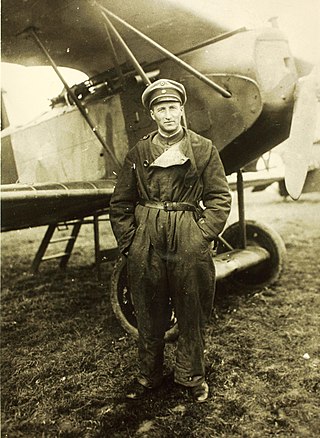Leutnant Georg Meyer was a German World War I fighter ace credited with confirmed victories over six enemy observation balloons and 18 enemy aircraft.

Doctor OberleutnantOtto Schmidt HOH, IC was a German World War I fighter ace credited with 20 aerial victories, including eight against enemy observation balloons. He commanded three different jagdstaffeln (squadrons) as well as a jagdgruppe.
Capitaine Paul Constant Homo was a French World War I flying ace noted for his prowess as an aerial observer directing artillery fire, as well as being credited with five aerial victories. During World War II, he served as a Lieutenant colonel. In 1954, he retired at the rank of Colonel.

Leutnant Hans Rosencrantz was a German World War I flying ace credited with five aerial victories, shared with his pilot Wilhelm Fahlbusch.
Leutnant Werner Wagener was a World War I flying ace credited with five aerial victories. As a Fokker Eindekker pilot, he was one of the first flying aces in history.
Vizefeldwebel Max Kahlow was a German World War I flying ace credited with six aerial victories.
Leutnant Friedrich von Mallinckrodt was a German World War I test pilot and flying ace credited with six aerial victories.
OffizierstellvertreterErich Schütze was a World War I flying ace credited with six aerial victories.
Vizefeldwebel Kurt Ungewitter was a German test pilot for Rumpler Flugzeugwerke and Albatros Flugzeugwerke, aircraft manufacturers in 1913. During World War I, he became a flying ace credited with seven aerial victories. He died in a postwar flying accident on 14 March 1927.
Leutnant Viktor Schobinger was a World War I flying ace credited with eight confirmed victories. Victory number two was confirmed over Charles Dawson Booker.
Sous lieutenantAndré-Henri Martenot de Cordou was a French World War I flying ace credited with eight aerial victories.

OffizierstellvertreterWilhelm Hippert IC was a World War I flying ace credited with eight confirmed aerial victories.
LeutnantRudolf Klimke IC was a German World War flying ace credited with 17 confirmed and two unconfirmed aerial victories. Serving initially as a bomber pilot, his aggressiveness in bombing England, and in shooting down a couple of enemy airplanes got him reassigned to a fighter squadron. After a string of a dozen victories during 1918, he was wounded in action on 21 September 1918.
Oberleutnant Hans Bethge HoH, IC was a German pilot who was one of the first World War I flying aces, as well as an aerial commander. He was credited with 20 aerial victories. He was also a squadron commander for the unusually long term of fourteen months.
Leutnant Heinrich Georg Geigl HOH, IC was a World War I German flying ace credited with thirteen aerial victories. His midair collision with a Sopwith Camel killed him; however, the Camel was confirmed as Geigl's 13th victory.
Leutnant Heinrich Arntzen was a German World War I flying ace credited with eleven aerial victories.
LeutnantHermann Pfeiffer IC was a German World War I flying ace credited with eleven aerial victories.

Vizefeldwebel Friedrich Manschott was a German World War I flying ace credited with 12 aerial victories.

OberleutnantHans Berr was a German professional soldier and World War I flying ace. At the start of the First World War, he served in a scout regiment until severely wounded; he then transferred to aviation duty. Once trained as a pilot, he helped pioneer the world's first dedicated fighter airplane, the Fokker Eindekker "flying gun". Flying one, Berr shot down two enemy airplanes in March 1916 as his contribution to the Fokker Scourge. Berr was then chosen to command one of the world's original fighter squadrons, Jagdstaffel 5. Leading his pilots by example, Berr scored eight more victories in a four week span in October - November 1916 while his pilots began to compile their own victories. Hans Berr was awarded Germany's highest military honor, the Pour le Merite, on 4 December 1916. During a 6 April 1917 dogfight, Berr and his wingman mortally collided.

During World War I, the national air services involved developed their own methods of assessing and assigning credit for aerial victories.







